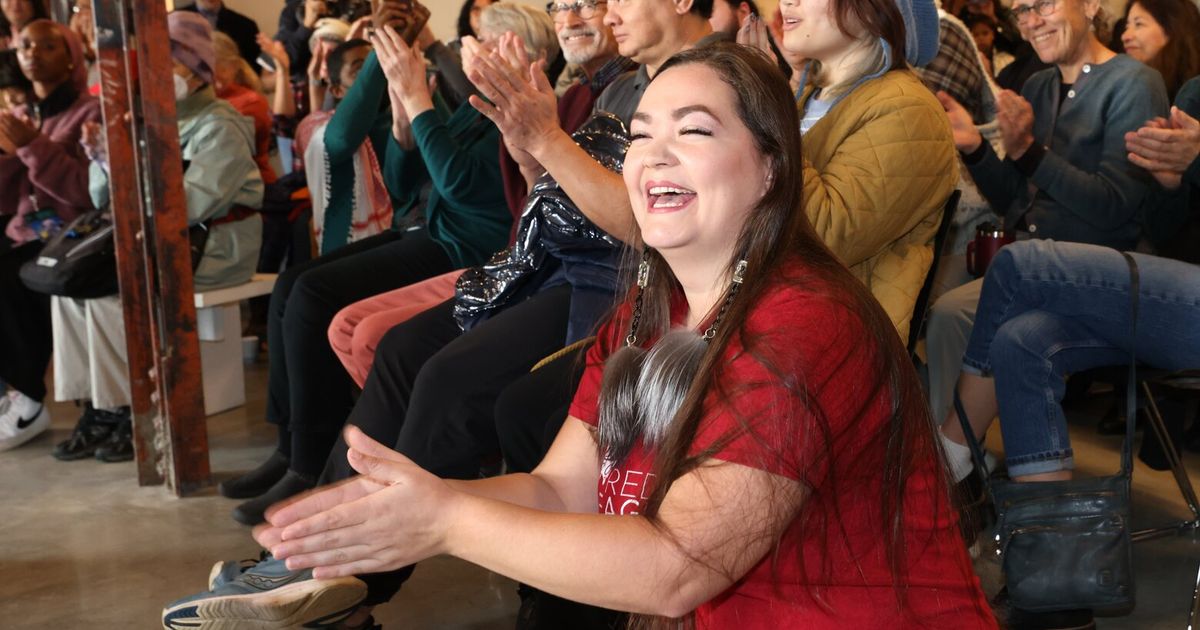The hustle of travelers on the trains that stop at Seattle’s historic King Street train station is set to merge with the bustle of young musicians, artists and theater groups.
Five youth-focused community organizations celebrated the opening Saturday of a new dedicated arts and culture space at the train station — a redbrick architectural gem with a prominent clock tower, open since 1906.
A group of young Native Americans from the Red Eagle Soaring theater group performed at the event before about 300 guests.
“We know who we are. We’re born from the stars,” they sang. “And our story has only just begun.”
The new arts hub, called Station Space, has a 60-year, rent-free lease from the city. It’s geared toward providing creative and cultural space for youth groups, targeting underserved Indigenous people and communities of color.
Olisa Enrico, executive director of the Cultural Space Agency that developed the project, called it “a new home here for young artists to thrive, a safe haven for artistic expression.”
It will feed the “dreams of young minds, who will find inspiration and a sense of belonging here,” she told the diverse audience. “You belong here.”
One anchor tenant in the space is Totem Star, started in 2010 by a couple of musicians — Daniel Pak from Hawaii and Thaddeus Turner from Seattle’s Central District — who gathered a group of 10 young men just released from juvenile detention and got them into playing and recording music.
That summer session launched the lives of those youngsters in a new and positive direction and the project grew, attracting young people from Bellingham to Olympia. Since 2013, Totem Star has operated a small music recording studio in West Seattle.
Now they are moving into a multisuite, state-of the-art recording studio at Station Space. Some equipment was donated by Sony, some by Vulcan Studios, a venture of the late Paul Allen. Vulcan sound engineers also provided their expertise.
“We’re all about championing and amplifying young people’s voices,” said Pak, welcoming them “with love and compassion so as to make music, to build community and to take creative risks.”
“Young artists that have an important voice, the voice of this city, will never again have to ask permission to write rehearse, record, collaborate, have a home to create,” he said. “This is the people’s studio.”
Seattle-born rapper Anthony Ray, better known as Sir Mix-a-Lot, spoke at the opening, saying he knew Pak from working together during the COVID pandemic to support live music venues.
When Pak told him of the plan to open a venue at King Street Station, “I’m like, really? Not gonna happen. That’s too expensive,” said Ray.
Pak had been insistent that he would get it done. “Guess what?” said Ray. “It’s done.”
“I don’t know how he pulled it off,” he said. “I’m so blown away. A 60-year lease!”
Public money backed by private money
Station Space fills King Street’s previously empty second floor, renovated at a cost of $4.5 million.
It supplements an existing third floor art gallery and performance space known as “ARTS at King Street Station,” owned and run by the city since 2019, that also houses the city’s Office of Arts and Culture.
With that, the two floors above the train station’s ornate ticketing and waiting area are now fully transformed into a hub for arts and culture.
The CSA is a Public Development Authority, initiated with public money and run partly with philanthropic money from private individuals and foundations.
With its rent-free lease, CSA will pay only for basic building upkeep while the community organizations that are Station Space tenants raise their own money to pay for their utilities and program staffing.
Rather than commercial art galleries or performance spaces run for profit, Station Space targets community organizations that provide artists a space to create.
Red Eagle Soaring conducts theater workshops and performances for Native American youths. Station Space gives it a small theater space for rehearsal.
“We’ve always had to bounce around and rent theater space wherever we could,” said executive director Russell Brooks. “This gives us a creative home.”
Two other tenants, The Jackson Street Music Project and Wh!psmart, aim to help young people learn how to earn a living from creative work.
Wh!psmart is using part of a $75,000 state grant for workforce development in the creative arts to start a mentorship program for young people starting out in music, theater, film or any other artistic field.
“We believe in people being able to make a living in creative fields,” said executive director Amy Lillard. “Everyone deserves to get paid. Our goal is to make sure that everyone has the tools that they need to succeed.”
James Gore of the Jackson Street Music Project has helped produce concerts and shows for decades. He plans classes for young people trying to break into the entertainment business, whether in music, theater or sports.
The fifth tenant, the Rhapsody Project, gives music classes and workshops for underprivileged young people. It will have a concert fundraiser at Benaroya Hall on Dec. 2.
Culture created by people with little support
Matthew Richter, a senior adviser to CSA who developed the plan for Station Space when he led the agency for three years, said the project democratizes culture by providing a building and workspace for creative people who would otherwise lack support.
“This large of an investment put in the Art Museum or the Opera or the Ballet is like par for the course. That’s what we expect to see,” he said. “This large of an investment made in emerging Black and Indigenous organizations that typically have been left out of the cultural space building that this town has done … that’s the inspiring part.”
“It’s not just like, oh, another arts spaces opening,” Richter added, “but a truly significant professionalized art space with really mammoth funding and support and representing the communities that have been left out for so long.”
Richter said just under $1 million of the project funding was public money from the city, state and county. The rest came from private foundations and individuals.
Enrico said she’s still fundraising to fill a financial gap of between $500,000 and $1 million in the building renovation costs.
“We’re waiting for some grants that have been applied for,” she said. “So we don’t know if that money is coming.”
“I’m hopeful. I feel supported and I’m learning how to ask for continued support,” Enrico added. “I look forward to creating relationships with the new members of city council and to continue to advocate for the arts in general and the arts economy.”






